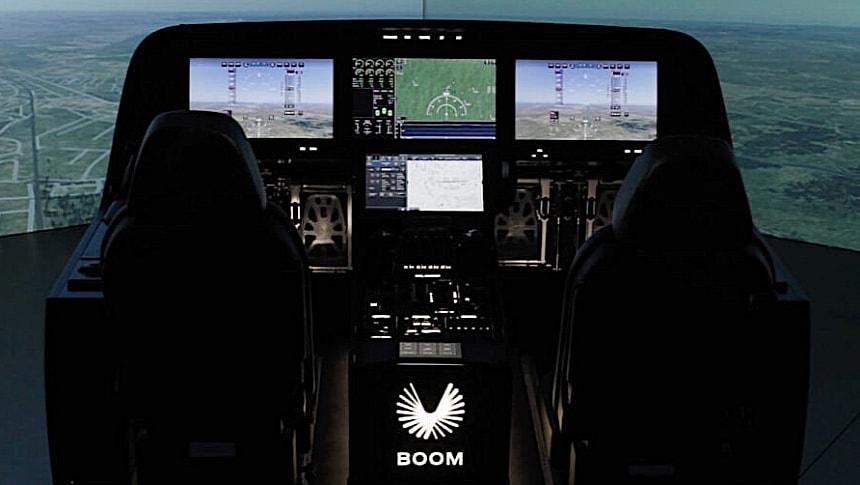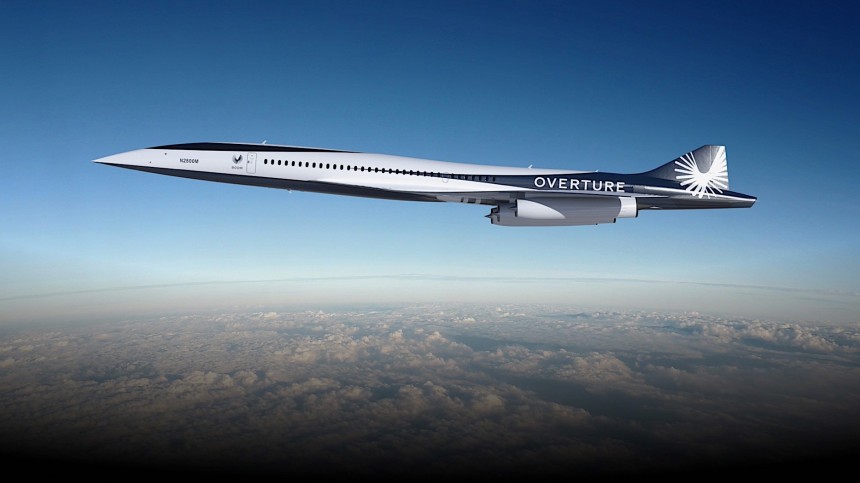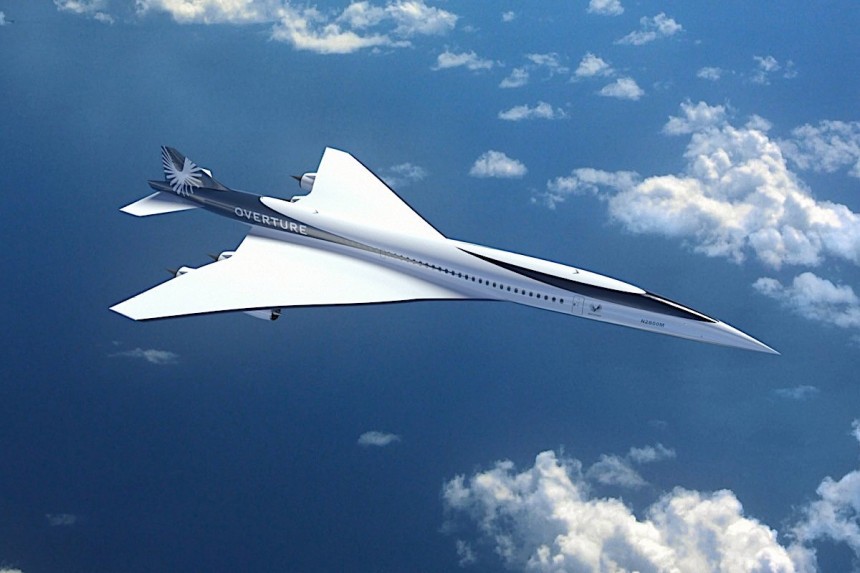They call it the Overture, and by all intents and purposes it will be the world's fastest airliner, capable of reaching speeds of Mach 1.7 (1,100 mph/1,800 kph). That's right, a supersonic passenger plane to follow in the footsteps of the mighty Concorde, currently in the works over in the U.S.
The Overture is the work of a company called Boom Supersonic. Just ten years old, the business has made it its mission to bring back supersonic air travel for the masses. That's not something we haven't heard about before, but these guys really seem to mean it. At least, that's the sense one gets every time word of new milestones being reached in the development of the project makes it our way.
It was about a month ago when Boom announced it had completed construction work on the "first supersonic airliner factory in the U.S." Called Superfactory, it was erected at the Piedmont Triad International Airport in Greensboro, North Carolina, in part because this state is where Wilbur and Orville Wright performed the world's first powered, controlled flight of an aicraft.
This week is when the Farnborough Airshow is taking place in the UK, and Boom used the opportunity to give us more updates on the project, and somewhere in there we found details of the Overture's flight deck.
The design may look ordinary to the untrained eye, but Boom says that it is reinventing the cockpit altogether with this thing. We'll leave it up to the pilots who will actually fly the plane to have their say on whether that's so or not.
The plane's flight deck will be built using the Honeywell Anthem avionics suite. Introduced by the industry giant in November 2021, the system was described ever since then as a game changer for aviation.
The always-on Anthem is the first cloud-connected cockpit system in aviation, and it is meant to aid pilots by giving them remote access to the info they need to prepare for a flight. It also brings all individual support systems (fuel, maintenance, or catering) into a single place, removing several third-party apps and websites from the equation.
The hardware part of the Anthem, comprising 2K resolution displays that on the Overture will be 17 inches in size, is as intuitive to use as a smartphone, allowing pilots to customize and reconfigure the data being shown. The symbols used to relay information are said to be the cleanest and most functional ones available today.
Aside from the Anthem, the Overture cockpit will also make use of a head-worn vision system developed by Universal Avionics. BAE Systems-made Active Control Sidesticks should provide pilots with an improved feel of the plane's motions and aerodynamic limits. This is the first time in the aviation industry that force-feedback sidesticks will be used on a commercial airliner.
Unlike the Concorde, which used a droop nose design to allow its pilots to see outside when taking off and landing, the Overture will use an augmented reality vision system that sends images of what's underneath the plane to a head-worn device and the primary display.
You may be inclined to think all these advancements would be a bit too much for pilots used with the current systems. Yet Boom says it has already tested its cockpit in the hands of commercial pilots, including the former Chief Concorde Pilot for British Airways, Mike Bannister, and these guys seem pretty hyped about it.
As far as the other components of the plane are concerned, Boom says everything is on track there as well. The plane's engines, called Symphony, are already undergoing testing, and we should have the first full operational core by the end of next year.
The hardware is made by Florida Turbine Technologies (FTT), a subsidiary of Kratos Defense & Security Solutions and it will be produced at the StandardAero facility in San Antonio, Texas. When fully operational, the assembly line should roll out about 330 engines per year, enough to power 82 Overture supersonic aircraft.
When ready, a total of four such twin-spool, medium-bypass turbofan powerplants, each of them generating 35,000 pounds of thrust at takeoff, will push the Overture plane to the insane speeds mentioned earlier
The engine will run completely on sustainable aviation fuel (SAF), and the tanks on the plane will be large enough to ensure it can reach distances of up to 4,800 miles (7,800 km). Because this is a medium-sized plane we're talking about, roughly 80 people will be able to take trips in it at a time.
Despite the gargantuan task that lies ahead, Boom Supersonic is confident that it remains on track to receive certification from both the Federal Aviation Administration (FAA) and the European Union Aviation Safety Agency (EASA) by the end of the decade, Which means we should expect the first test flight of the supersonic airliner at about the same time.
It was about a month ago when Boom announced it had completed construction work on the "first supersonic airliner factory in the U.S." Called Superfactory, it was erected at the Piedmont Triad International Airport in Greensboro, North Carolina, in part because this state is where Wilbur and Orville Wright performed the world's first powered, controlled flight of an aicraft.
This week is when the Farnborough Airshow is taking place in the UK, and Boom used the opportunity to give us more updates on the project, and somewhere in there we found details of the Overture's flight deck.
The design may look ordinary to the untrained eye, but Boom says that it is reinventing the cockpit altogether with this thing. We'll leave it up to the pilots who will actually fly the plane to have their say on whether that's so or not.
The plane's flight deck will be built using the Honeywell Anthem avionics suite. Introduced by the industry giant in November 2021, the system was described ever since then as a game changer for aviation.
The hardware part of the Anthem, comprising 2K resolution displays that on the Overture will be 17 inches in size, is as intuitive to use as a smartphone, allowing pilots to customize and reconfigure the data being shown. The symbols used to relay information are said to be the cleanest and most functional ones available today.
Aside from the Anthem, the Overture cockpit will also make use of a head-worn vision system developed by Universal Avionics. BAE Systems-made Active Control Sidesticks should provide pilots with an improved feel of the plane's motions and aerodynamic limits. This is the first time in the aviation industry that force-feedback sidesticks will be used on a commercial airliner.
Unlike the Concorde, which used a droop nose design to allow its pilots to see outside when taking off and landing, the Overture will use an augmented reality vision system that sends images of what's underneath the plane to a head-worn device and the primary display.
You may be inclined to think all these advancements would be a bit too much for pilots used with the current systems. Yet Boom says it has already tested its cockpit in the hands of commercial pilots, including the former Chief Concorde Pilot for British Airways, Mike Bannister, and these guys seem pretty hyped about it.
As far as the other components of the plane are concerned, Boom says everything is on track there as well. The plane's engines, called Symphony, are already undergoing testing, and we should have the first full operational core by the end of next year.
When ready, a total of four such twin-spool, medium-bypass turbofan powerplants, each of them generating 35,000 pounds of thrust at takeoff, will push the Overture plane to the insane speeds mentioned earlier
The engine will run completely on sustainable aviation fuel (SAF), and the tanks on the plane will be large enough to ensure it can reach distances of up to 4,800 miles (7,800 km). Because this is a medium-sized plane we're talking about, roughly 80 people will be able to take trips in it at a time.
Despite the gargantuan task that lies ahead, Boom Supersonic is confident that it remains on track to receive certification from both the Federal Aviation Administration (FAA) and the European Union Aviation Safety Agency (EASA) by the end of the decade, Which means we should expect the first test flight of the supersonic airliner at about the same time.














